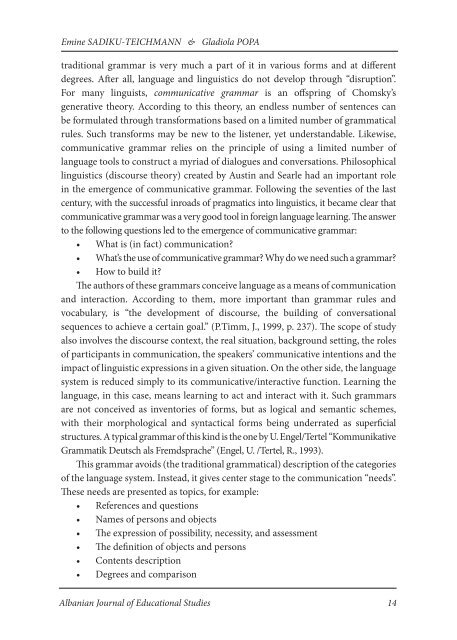Download - qendra per arsim demokratik
Download - qendra per arsim demokratik
Download - qendra per arsim demokratik
Create successful ePaper yourself
Turn your PDF publications into a flip-book with our unique Google optimized e-Paper software.
Emine SADIKU-TEICHMANN & Gladiola POPAtraditional grammar is very much a part of it in various forms and at differentdegrees. After all, language and linguistics do not develop through “disruption”.For many linguists, communicative grammar is an offspring of Chomsky’sgenerative theory. According to this theory, an endless number of sentences canbe formulated through transformations based on a limited number of grammaticalrules. Such transforms may be new to the listener, yet understandable. Likewise,communicative grammar relies on the principle of using a limited number oflanguage tools to construct a myriad of dialogues and conversations. Philosophicallinguistics (discourse theory) created by Austin and Searle had an important rolein the emergence of communicative grammar. Following the seventies of the lastcentury, with the successful inroads of pragmatics into linguistics, it became clear thatcommunicative grammar was a very good tool in foreign language learning. The answerto the following questions led to the emergence of communicative grammar:• What is (in fact) communication?• What’s the use of communicative grammar? Why do we need such a grammar?• How to build it?The authors of these grammars conceive language as a means of communicationand interaction. According to them, more important than grammar rules andvocabulary, is “the development of discourse, the building of conversationalsequences to achieve a certain goal.” (P.Timm, J., 1999, p. 237). The scope of studyalso involves the discourse context, the real situation, background setting, the rolesof participants in communication, the speakers’ communicative intentions and theimpact of linguistic expressions in a given situation. On the other side, the languagesystem is reduced simply to its communicative/interactive function. Learning thelanguage, in this case, means learning to act and interact with it. Such grammarsare not conceived as inventories of forms, but as logical and semantic schemes,with their morphological and syntactical forms being underrated as su<strong>per</strong>ficialstructures. A typical grammar of this kind is the one by U. Engel/Tertel “KommunikativeGrammatik Deutsch als Fremdsprache” (Engel, U. /Tertel, R., 1993).This grammar avoids (the traditional grammatical) description of the categoriesof the language system. Instead, it gives center stage to the communication “needs”.These needs are presented as topics, for example:• References and questions• Names of <strong>per</strong>sons and objects• The expression of possibility, necessity, and assessment• The definition of objects and <strong>per</strong>sons• Contents description• Degrees and comparisonAlbanian Journal of Educational Studies 14


